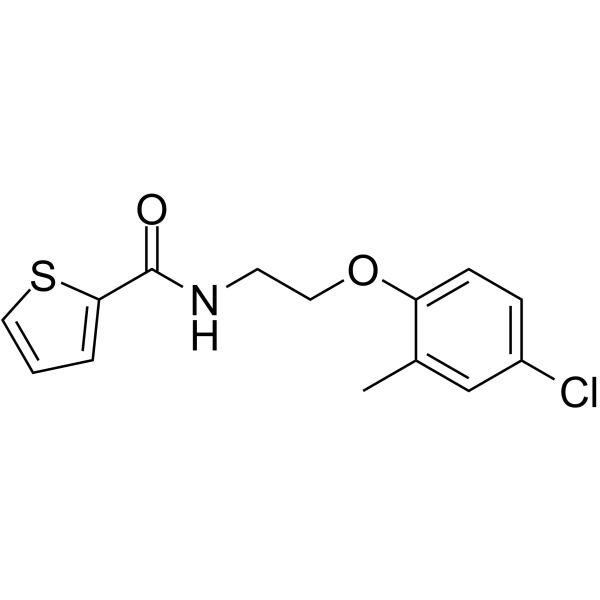
ML402
CAS No. 298684-44-3
ML402( ZINC3671497 | N-[2-(4-chloro-2-methylphenoxy)ethyl]thiophene-2-carboxamide )
Catalog No. M26759 CAS No. 298684-44-3
ML402 is an activator of TREK-1 and TREK-2 with EC50s of 13.7 μM and 5.9 μM.
Purity : >98% (HPLC)
 COA
COA
 Datasheet
Datasheet
 HNMR
HNMR
 HPLC
HPLC
 MSDS
MSDS
 Handing Instructions
Handing Instructions
| Size | Price / USD | Stock | Quantity |
| 2MG | 40 | Get Quote |


|
| 5MG | 65 | Get Quote |


|
| 10MG | 110 | Get Quote |


|
| 25MG | 222 | Get Quote |


|
| 50MG | 357 | Get Quote |


|
| 100MG | 530 | Get Quote |


|
| 500MG | 1152 | Get Quote |


|
| 1G | Get Quote | Get Quote |


|
Biological Information
-
Product NameML402
-
NoteResearch use only, not for human use.
-
Brief DescriptionML402 is an activator of TREK-1 and TREK-2 with EC50s of 13.7 μM and 5.9 μM.
-
DescriptionML402 is an activator of TREK-1 and TREK-2 with EC50s of 13.7 μM and 5.9 μM.(In Vitro):ML402 targets TRAAK with EC50 of 13.6 μM.
-
In VitroXenopus oocyte two-electrode voltage-clamp measurements show that ML335 and ML402 activate K2P2.1 and K2P10.1 but not K2P4.1(14.3±2.7 μM, K2P2.1-ML335; 13.7±7.0 μM, K2P2.1-ML402; 5.2±0.5 μM, K2P10.1-ML335; and 5.9±1.6 μM, K2P10.1-ML402). The K2P modulator pocket has a single difference among TREK subfamily members at the cation-π interaction position, K2P2.1 Lys271, which is also a lysine in K2P10.1 but a glutamine in K2P4.1.Swapping the Lys271 equivalent between K2P2.1 and K2P4.1 results in a clear phenotype reversal for ML335 and M402 activation. K2P2.1 (K271Q) is insensitive to ML335 and ML402, whereas K2P4.1 (Q258K) responds to both with a similar EC50 to K2P2.1 (14.3±2.7 μM, K2P2.1-ML335; 16.2±3.0 μM, K2P4.1(Q258K)-ML335; 13.7±7.0 μM, K2P2.1-ML402; 13.6±1.5 μM, K2P4.1 (Q258K)-ML402) but with a lower magnitude response than K2P2.1.
-
In Vivo——
-
SynonymsZINC3671497 | N-[2-(4-chloro-2-methylphenoxy)ethyl]thiophene-2-carboxamide
-
PathwayCell Cycle/DNA Damage
-
TargetPotassium Channel
-
RecptorEstrogen Receptor/ERR
-
Research Area——
-
Indication——
Chemical Information
-
CAS Number298684-44-3
-
Formula Weight295.78
-
Molecular FormulaC14H14ClNO2S
-
Purity>98% (HPLC)
-
SolubilityIn Vitro:?DMSO : ≥ 100 mg/mL (338.09 mM)
-
SMILESCc1cc(Cl)ccc1OCCNC(=O)c1cccs1
-
Chemical Name——
Shipping & Storage Information
-
Storage(-20℃)
-
ShippingWith Ice Pack
-
Stability≥ 2 years
Reference
1.Saheli Sarkar, et al.Estradiol Hemisuccinate-Modified Surface-Engineered Carbon Dots: Target-Specific Theranostic Agent. ACS Sustainable Chemistry & Engineering 2017 5 (9), 8356-8369
molnova catalog



related products
-
Amsacrine
Amsacrine (mAMSA) an antineoplastic agent which can intercalate into the DNA of tumor cells.
-
DPO-1
DPO-1 is a blocker of IKur ultrarapid delayed rectifier potassium current and KV1.5 channels.
-
Hydroquinidine
Dihydroquinidine is an organic compound and as a cinchona alkaloid closely related to quinine.



 Cart
Cart
 sales@molnova.com
sales@molnova.com


